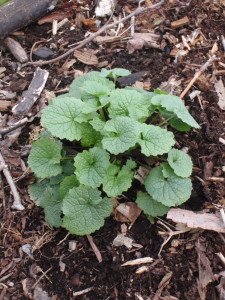double duty
Perhaps it was the hours spent pulling weeds and invasive vines that led me to natural dyeing and foraging. As we worked, I wondered what can be done with these weeds? It seemed a shame to ‘gather’ these plants and essentially throw them away, and quite ‘un-colonial’ not to use everything.
Coincidentally, I happened upon a copy of Euell Gibbons’, Stalking the Wild Asparagus. Do you remember the Grape Nut commercials in the 1970s, with Gibbons talking about eating a pine tree? He poetically outlines uses for many so-called weeds (more on the dandelion in a later post), but he does not mention the now-prevalent garlic mustard (Alliaria petiolata) and maybe that is because it was not as invasive then. My research tells me that the deer won’t eat the garlic mustard, promoting its overtaking of the forest floor, and to add insult to injury, the scattered seed lasts for five years.
On the new book shelf at the Library sat a copy of Urban Foraging by Ellen Zachos, a perfect guide for modern foragers with color photos and recipes. She adores the garlic mustard plant, for “it’s insanely nutritious, higher in fiber, beta-carotene, vitamins C and E, and zinc than either spinach or kale. It’s also very high in calcium, iron and omega-3 fatty acids.” She recommends making pesto from the foraged new season leaves and so we did. Put your foraged garlic mustard leaves, salt, pepper, olive oil, Parmesan, and I added a dribble of honey, into the Cuisinart and voilà, yummy pesto.
[Ellen Zachos, Backyard Foraging, (Storey Publishing, 2013), pgs. 42-43]